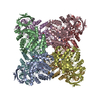+Search query
-Structure paper
| Title | Functional characterization and structural basis of an efficient ochratoxin A-degrading amidohydrolase. |
|---|---|
| Journal, issue, pages | Int J Biol Macromol, Vol. 278, Issue Pt 3, Page 134831, Year 2024 |
| Publish date | Aug 18, 2024 |
 Authors Authors | Yumei Hu / Longhai Dai / Yuhang Xu / Du Niu / Xuechun Yang / Zhenzhen Xie / Panpan Shen / Xian Li / Hao Li / Lilan Zhang / Jian Min / Rey-Ting Guo / Chun-Chi Chen /  |
| PubMed Abstract | Ochratoxin A (OTA) contamination in various agro-products poses a serious threat to the global food safety and human health, leading to enormous economic losses. Enzyme-mediated OTA degradation is an ...Ochratoxin A (OTA) contamination in various agro-products poses a serious threat to the global food safety and human health, leading to enormous economic losses. Enzyme-mediated OTA degradation is an appealing strategy, and the search for more efficient enzymes is a prerequisite for achieving this goal. Here, a novel amidohydrolase, termed PwADH, was demonstrated to exhibit 7.3-fold higher activity than that of the most efficient OTA-degrading ADH3 previously reported. Cryo-electron microscopy structure analysis indicated that additional hydrogen-bond interactions among OTA and the adjacent residue H163, the more compact substrate-binding pocket, and the wider entry to the substrate-access cavity might account for the more efficient OTA-degrading activity of PwADH compared with that of ADH3. We conducted a structure-guided rational design of PwADH and obtained an upgraded variant, G88D, whose OTA-degrading activity was elevated by 1.2-fold. In addition, PwADH and the upgraded G88D were successfully expressed in the industrial yeast Pichia pastoris, and their catalytic activities were compared to those of their counterparts produced in E. coli, revealing the feasibility of producing PwADH and its variants in industrial yeast strains. These results illustrate the structural basis of a novel, efficient OTA-degrading amidohydrolase and will be beneficial for the development of high-efficiency OTA-degrading approaches. |
 External links External links |  Int J Biol Macromol / Int J Biol Macromol /  PubMed:39163957 PubMed:39163957 |
| Methods | EM (single particle) |
| Resolution | 2.33 - 2.37 Å |
| Structure data | EMDB-39098, PDB-8yag: EMDB-39101, PDB-8yak: |
| Chemicals |  ChemComp-ZN:  ChemComp-97U: |
| Source |
|
 Keywords Keywords | HYDROLASE / amide hydrolase / Iron-binding / Ochratoxin A / ZN |
 Movie
Movie Controller
Controller Structure viewers
Structure viewers About Yorodumi Papers
About Yorodumi Papers







 pseudoxanthomonas wuyuanensis (bacteria)
pseudoxanthomonas wuyuanensis (bacteria)